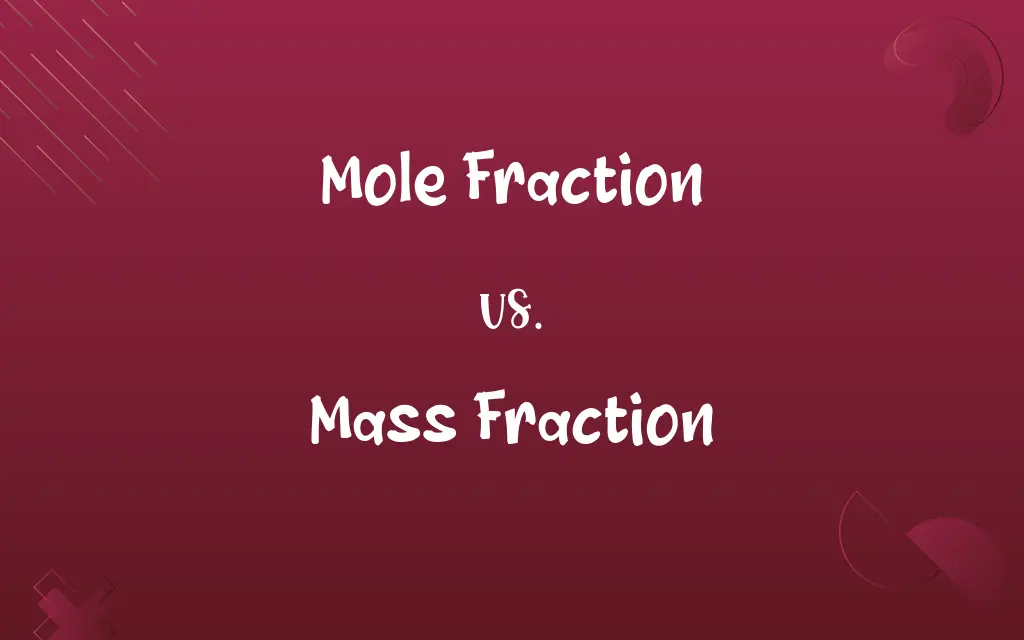Mole Fraction vs. Mass Fraction: Know the Difference

By Shumaila Saeed || Published on January 3, 2024
Mole fraction is the ratio of moles of a component to total moles in a mixture, while mass fraction is the ratio of mass of a component to total mass of the mixture.

Key Differences
Mole Fraction is a dimensionless quantity representing the concentration of a component in a mixture, expressed as the ratio of the number of moles of that component to the total number of moles of all components. Mass Fraction, on the other hand, represents the concentration of a component based on mass, calculated as the mass of the component divided by the total mass of the mixture.
Shumaila Saeed
Jan 03, 2024
Mole Fraction is particularly useful in chemical reactions where the reaction rates are based on the number of molecules and their interactions. It's often used in gas mixtures and solutions. Mass Fraction is more commonly used in situations where the actual mass of the components is more relevant, such as in mixing ingredients in a recipe or in material science.
Shumaila Saeed
Jan 03, 2024
The value of Mole Fraction can be influenced by the molecular weight of the components, as it is a count of molecules, not their weight. This means that even small amounts of a substance with high molecular weight can significantly affect the mole fraction. In contrast, Mass Fraction is directly proportional to the weight of each component, making it more straightforward for practical measurements.
Shumaila Saeed
Jan 03, 2024
In the calculation of Mole Fraction, the molecular weights of the substances need to be known to convert mass into moles. However, for Mass Fraction, such conversions are not necessary, as it deals directly with the mass of the components.
Shumaila Saeed
Jan 03, 2024
Mole Fraction is often used in thermodynamic calculations, such as determining partial pressures in gas mixtures or concentrations in solutions. Mass Fraction is more common in engineering and food science, where the physical mass of the components is more significant for the desired outcome of a process.
Shumaila Saeed
Jan 03, 2024
ADVERTISEMENT
Comparison Chart
Definition
Ratio of moles of a component to total moles in a mixture
Ratio of mass of a component to total mass of a mixture
Shumaila Saeed
Jan 03, 2024
Influenced by
Number of molecules, molecular weight
Actual mass of the components
Shumaila Saeed
Jan 03, 2024
Common Usage
Chemical reactions, gas mixtures, solutions
Mixing ingredients, material science, engineering
Shumaila Saeed
Jan 03, 2024
Calculation Requirement
Need to convert mass to moles
Directly based on mass, no conversion needed
Shumaila Saeed
Jan 03, 2024
ADVERTISEMENT
Mole Fraction and Mass Fraction Definitions
Mole Fraction
A way of expressing the composition of a mixture or solution in terms of the ratio of moles of each component.
The mole fraction of solute in a dilute solution is typically very small compared to that of the solvent.
Shumaila Saeed
Dec 12, 2023
Mass Fraction
A measure of the concentration of a substance in a mixture represented by the mass of the substance divided by the total mass of the mixture.
The mass fraction of salt in seawater is about 3.5%.
Shumaila Saeed
Dec 12, 2023
Mole Fraction
The proportion of a constituent to the total amount of all constituents in a mixture, measured in moles.
The mole fraction of ethanol in a solution can be determined by dividing the moles of ethanol by the total moles in the solution.
Shumaila Saeed
Dec 12, 2023
Mass Fraction
The proportion of a constituent to the total mass of all constituents in a mixture.
In a steel alloy, the mass fraction of carbon determines its hardness and strength.
Shumaila Saeed
Dec 12, 2023
Mole Fraction
A measure of the concentration of a component in a mixture expressed as a ratio of moles.
In a mixture of nitrogen and oxygen, if nitrogen constitutes 3 moles and oxygen 1 mole, the mole fraction of nitrogen is 0.75.
Shumaila Saeed
Dec 12, 2023
ADVERTISEMENT
Mass Fraction
A numerical expression indicating how much of a substance is present relative to the total mass.
The mass fraction of protein in a nutrition bar is 0.15, signifying that 15% of the bar's mass is protein.
Shumaila Saeed
Dec 12, 2023
Mole Fraction
A unitless quantity representing the fraction of the total number of moles contributed by an individual component.
In an air sample, the mole fraction of carbon dioxide is typically around 0.0004.
Shumaila Saeed
Dec 12, 2023
Mass Fraction
The fraction representing the mass contribution of a specific element or compound in a material.
The mass fraction of carbon in a diamond is 1.0, as carbon makes up the entire mass of the diamond.
Shumaila Saeed
Dec 12, 2023
Mole Fraction
A term used in chemistry to describe the ratio of the number of moles of a particular substance to the total number of moles of all substances present.
The mole fraction of a gas in a mixture is key to calculating its partial pressure.
Shumaila Saeed
Dec 12, 2023
Mass Fraction
A way of expressing the composition of a mixture or solution in terms of the ratio of mass of each component.
The mass fraction of flour in a bread dough is crucial for achieving the right texture.
Shumaila Saeed
Dec 12, 2023
Repeatedly Asked Queries
How is mass fraction calculated?
Mass fraction (W) is calculated by dividing the mass of the component of interest by the total mass of the mixture and multiplying by 100% for a percentage.
Shumaila Saeed
Jan 03, 2024
What is a mass fraction?
Mass fraction is a ratio that expresses the mass of a particular substance in a mixture relative to the total mass of the mixture.
Shumaila Saeed
Jan 03, 2024
What is a mole fraction?
A mole fraction is a dimensionless quantity representing the ratio of the moles of a specific component to the total moles in a mixture.
Shumaila Saeed
Jan 03, 2024
What are the units for mole fraction?
Mole fraction is a dimensionless quantity and has no units.
Shumaila Saeed
Jan 03, 2024
Can mole fractions and mass fractions be greater than 1?
No, mole fractions and mass fractions are typically between 0 and 1, representing fractions or percentages.
Shumaila Saeed
Jan 03, 2024
What does a mole fraction of 0.5 signify in a binary mixture?
A mole fraction of 0.5 means that the two components are present in equal moles in the mixture.
Shumaila Saeed
Jan 03, 2024
What are the units for mass fraction?
Mass fraction is usually expressed as a percentage, so it is typically given in percentage units (%).
Shumaila Saeed
Jan 03, 2024
How is mole fraction calculated?
Mole fraction (X) is calculated by dividing the moles of the component of interest by the total moles in the mixture.
Shumaila Saeed
Jan 03, 2024
What does a mass fraction of 0.75 mean?
A mass fraction of 0.75 indicates that 75% of the total mass of the mixture is attributed to the specific component.
Shumaila Saeed
Jan 03, 2024
How are mole fraction and mass fraction related in an ideal solution?
In an ideal solution, mole fractions are directly proportional to mass fractions.
Shumaila Saeed
Jan 03, 2024
Why is mole fraction important in vapor-liquid equilibrium calculations?
Mole fraction is crucial in calculating partial pressures and phase equilibria in vapor-liquid systems.
Shumaila Saeed
Jan 03, 2024
Are mass fractions additive?
Yes, the sum of mass fractions for all components in a mixture equals 100% (or 1 when expressed as a fraction).
Shumaila Saeed
Jan 03, 2024
What happens to mole fractions and mass fractions in a non-ideal solution?
In a non-ideal solution, mole fractions and mass fractions may not be directly proportional due to interactions between molecules.
Shumaila Saeed
Jan 03, 2024
Why are mole fractions and mass fractions used in chemistry?
They are used to quantify the composition of mixtures, making it easier to compare and analyze the presence of specific substances.
Shumaila Saeed
Jan 03, 2024
How can you convert between mole fraction and mass fraction?
You can convert between them using the molar mass of the components in the mixture.
Shumaila Saeed
Jan 03, 2024
Which fraction is more commonly used in chemical calculations?
Mole fraction is more commonly used in chemical calculations, especially in thermodynamics and stoichiometry.
Shumaila Saeed
Jan 03, 2024
Can you use mole fractions and mass fractions interchangeably?
No, mole fractions and mass fractions represent different aspects of composition and cannot be used interchangeably.
Shumaila Saeed
Jan 03, 2024
Which fraction is more suitable for expressing the concentration of solutes in solutions?
Mass fraction is more suitable for expressing the concentration of solutes in solutions, especially when dealing with mass-related properties like density.
Shumaila Saeed
Jan 03, 2024
In a mixture of gases, how does the mole fraction relate to the partial pressure of a gas?
The mole fraction of a gas in a mixture is directly proportional to its partial pressure, according to Dalton's law of partial pressures.
Shumaila Saeed
Jan 03, 2024
Are mole fractions additive?
Yes, the sum of mole fractions for all components in a mixture equals 1.
Shumaila Saeed
Jan 03, 2024
Share this page
Link for your blog / website
HTML
Link to share via messenger
About Author
Written by
Shumaila SaeedShumaila Saeed, an expert content creator with 6 years of experience, specializes in distilling complex topics into easily digestible comparisons, shining a light on the nuances that both inform and educate readers with clarity and accuracy.









































































